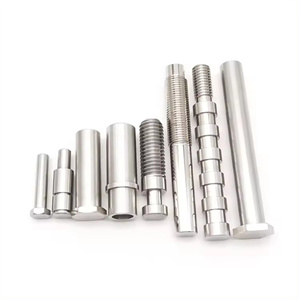The machining production of Dowel Pin Shafts is a process that requires high precision and strict quality control. Dowel Pin Shafts play a crucial role in precise positioning and connection in mechanical assembly, and are widely used in fields such as molds, fixtures, and mechanical components. The selection of materials is usually based on the usage environment and requirements, commonly including high-strength alloy steel, stainless steel, etc., to ensure that they have sufficient hardness and wear resistance. The preparation of the blank can be achieved through methods such as cold drawing, forging, or turning to initially form the approximate shape of the shaft.
In the machining process, key steps include:
Turning: used for precise machining of the outer diameter of the shaft, ensuring that its diameter size and cylindricity meet design requirements.
Grinding: Further improve the surface roughness and dimensional accuracy of the shaft, making the surface of the shaft smoother.
Chamfer and Deburring: Chamfer both ends of the shaft to remove burrs generated during the machining process, in order to prevent scratching of the mating parts.
In order to ensure the high accuracy of the positioning pin shaft, it is necessary to strictly control the machining parameters, such as cutting speed, feed rate, and cutting depth, during the machining process. For example, when processing positioning pin shafts used in precision molds, the diameter tolerance requirement for the shaft may reach the micrometer level, which requires the use of high-precision machine tools and measuring tools for processing and inspection. In terms of quality inspection, precision measuring tools such as micrometers and projectors are used to measure the diameter, length, straightness, roundness, and other parameters of the shaft. In the assembly of automotive engines, the accuracy of Dowel Pin Shafts directly affects the assembly accuracy of various components and the performance of the engine.
CNC machining is a commonly used and efficient method for producing Shafts. As Shafts are an indispensable component of mechanical transmission systems, they require high precision, high surface quality, and good mechanical performance. CNC machining can meet these requirements, ensuring the accuracy and reliability of Shafts.
In the process of producing Shafts in CNC machining, the following steps are usually included:
Design and programming: Use CAD (computer-aided design) software to create a 3D model of Shafts and determine its dimensions, shape, material, and other parameters. Then, using CAM (Computer Aided Manufacturing) software, the CAD model is converted into a machining program (usually G code) that can be executed by CNC machine tools.
Material preparation: Select materials suitable for Shafts manufacturing, such as stainless steel, carbon steel, alloy steel, etc. Prepare raw materials and perform cutting, pre-treatment, and other operations as needed.
CNC machining: Install raw materials on CNC machine tools and perform machining operations such as cutting, drilling, and milling according to the machining program. CNC machine tools precisely control the movement and rotation of cutting tools through computer control systems to ensure the dimensional accuracy and surface quality of Shafts.
Quality control: Conduct quality inspection on the processed Shafts, including size measurement, surface smoothness inspection, mechanical performance testing, etc. Ensure that Shafts comply with design requirements and relevant standards.
Subsequent treatment: Surface treatment of Shafts, such as spraying, heat treatment, etc., as needed to improve their corrosion resistance, wear resistance, and other properties.
